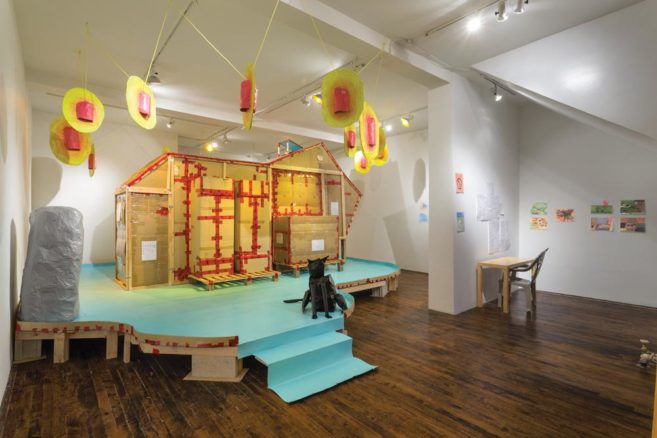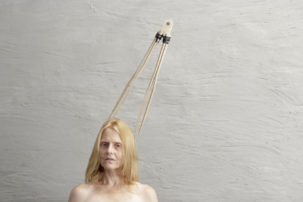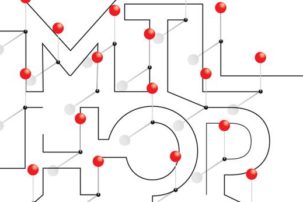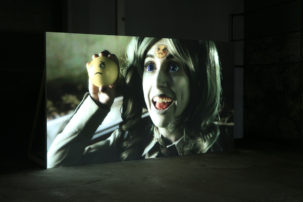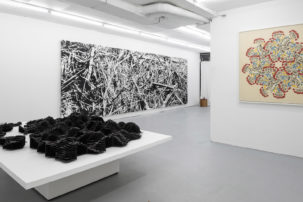Sherry Walchuk’s “Outbuilding I: Sun Tunnel Satellite Dishes,” the artist’s first exhibition in Montreal since 2013, centres on one large work: the sculptural installation that gives the show its title. Elevated on a riser carpeted with cheery green astroturf and ringed by a white fence, Sun Tunnel Satellite Dishes (2016–19) is constructed out of hardware store materials (wood, rainproof plastic sheeting, bug lights, a tarp zipper) and hobby-craft art supplies (painted cardboard, papier-mâché, tape). Its two satellite dishes, with interiors painted in a glowing red-yellow gradient, are mounted on papier-mâché mounds styled to look like miniature mountains and joined by a platform the length of a human body. The whole ensemble is covered in plastic sheeting that makes it into a greenhouse-like tent. The structure is intended as a kind of makeshift therapeutic chamber, derived from Walchuk’s research into energy healing. The viewer is meant to enter into the Sun Tunnel in order to “blast away negative thought patterns using the sun’s force and replace them with the sun’s light,” according to the exhibition text by Nasrin Himada.
As its designation of “Outbuilding I” suggests, Sun Tunnel Satellite Dishes is part of a larger series. In fact, Walchuk’s output has two main channels: installation structures with a participatory, performative dimension, and a drawing practice that serves mainly as diagramming and brainstorming research for the larger works. Both of these streams issue forth from the remarkably developed conceptual armature of Walchuk’s imaginary care facility, a kind of fictional hospital/hospice for which Walchuk invents various departments, architectural units and novel therapeutic treatments. Drawings included in this exhibition—in a flat, deliberately childlike pencil-crayon style—illustrate a series of fantastical hospital beds from Walchuk’s “Room of Suns,” including ones with titles like Rising Sun with Extra Spikes and Sun Blast with Air Flaps (both 2019). Another group of drawings depicts posture-aiding contraptions called Confidence Generators (2016–17) meant to lift a patient’s spirits by elevating their arms into sun salutation–like poses.
While Sun Tunnel is intended to instill a sense of confidence and connection in patients, a related rain chamber is designed to cleanse anger and depression—though not present in the exhibition, it is documented in the short animated instructional video that Walchuk made to explain the purpose of her devices. Naturally, the homemade and improvisatory quality of Walchuk’s eccentric constructions, with their dollar-store materials and dubious clinical methods, raises the question of how they are intended to be experienced. At CIRCA Art Actuel, viewers of this exhibition are not actually able to enter the Sun Tunnel. Rather, it functions as a full-sized model of a potentially real structure. (Nonetheless, most of Walchuk’s large works are meant for use.)
Drawing on her own upbringing in rural/suburban Mission, BC, and her experience as a caregiver for her parents, Walchuk describes herself as inspired not by art, but necessity: the idea that someone needs what she’s making, in a practical, functional sense. Her imaginary care facility is a place to prepare for death, but also to deal with recovery and rehabilitation in general, whether it’s related to aging, addiction, illness, mourning, abuse or debt (in other words, physical as well as existential problems). These struggles, and the way that Walchuk approaches them, are decidedly unsexy, speaking as they do of things that rarely cross the threshold of contemporary art: the pain of those at middle age or older, middle-class or lower, approached not through a theoretical, political or world-historical lens, but in the individual terms of everyday life, through vernacular creativity, accessible materials and DIY wellness. That said, Walchuk’s fantasy world is anything but ordinary, populated as it is with anthropomorphic architecture, quixotic machinery and utopian transformations: “presses” to reshape one’s aura, bodies becoming suns, rivers, mountains, etc.
Even the art historical reference in the work—Nancy Holt’s Sun Tunnels (1973–76)—comes from close to home. Walchuk’s mother became fascinated by Land Art several years ago, which spurred Walchuk’s own rediscovery of it. (The show also includes drawings that Walchuk has made of scuptures by her mother—burnt logs of firewood studded with acupuncture needles.) What attracted Walchuk to Nancy Holt, in particular, was the idea of rendering monumental, and even cosmic, natural elements (the sun, the desert) on a human scale.
Most of Walchuk’s real and imagined constructions are attempting to move or transform, though their bulky shapes and makeshift materials reflect the difficulty of manoeuvring, of making change, of either living with or saying goodbye to our earthly vessels. Walchuk’s art can’t help but be a little funny: with our limited resources, most human attempts to transcend circumstance often end up looking absurd. Nevertheless, “Outbuilding I: Sun Tunnel Satellite Dishes” testifies to the boundless creativity with which one can approach a task at which no one really succeeds: changing back into the universe.
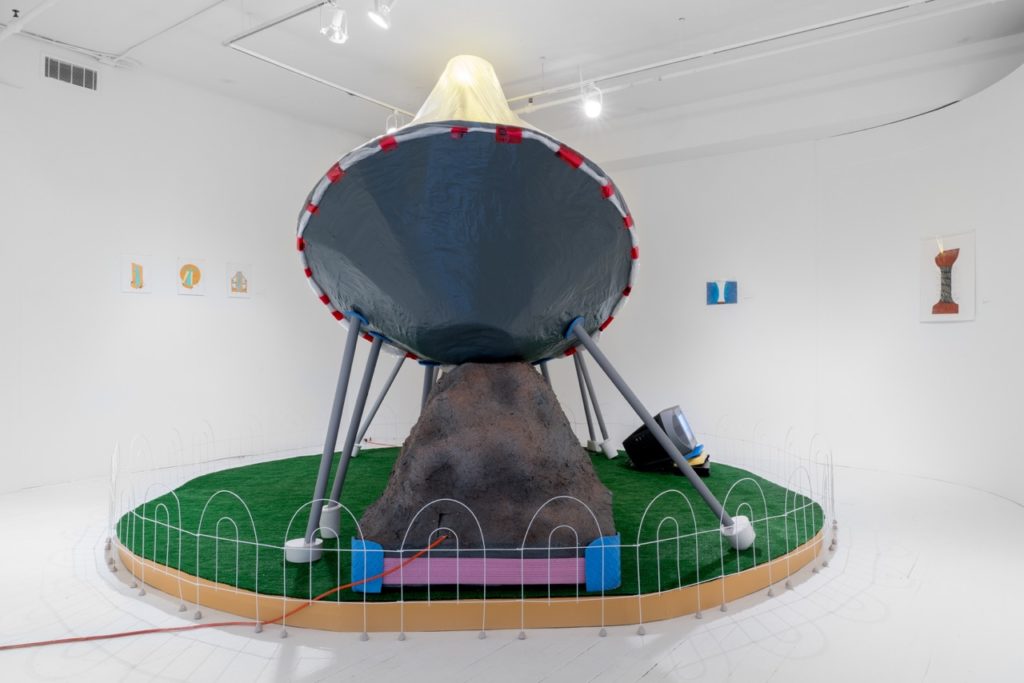
Sherry Walchuk, Sun Tunnel Satellite Dishes (installation view: behind the dish), 2016–19. Papier mâché, cardboard, wood, tape, plastic, acrylic paint, plaster, lights, astroturf, TV, DVD player, foam and electrical cords, 3.65 x 3.65 x 2.43 m. Photo: Jean-Michael Seminaro.

Sherry Walchuk, Instructions For Sessions, 2018. Animation (7 min 32 sec), TV, foam and DVD player. Photo: Jean-Michael Seminaro.

Sherry Walchuk, Confidence Generators 1, 2, & 3, 2016–17. Pencil crayon on paper in plastic page protector, 21.5 x 27.9 cm each. Photo: Jean-Michael Seminaro.

Sherry Walchuk, Sun Tunnel Satellite Dishes on top of garden tier pyramid, 2016. Pencil crayon on paper in plastic page protector, 21.5 x 27.9 cm. Photo: Jean-Michael Seminaro.

Sherry Walchuk, Where the Sun Tunnels might have been made (my dad’s neighbour’s trailer), 2017. Pencil crayon on paper in plastic page protector, 21.5 x 27.9 cm. Photo: Jean-Michael Seminaro.

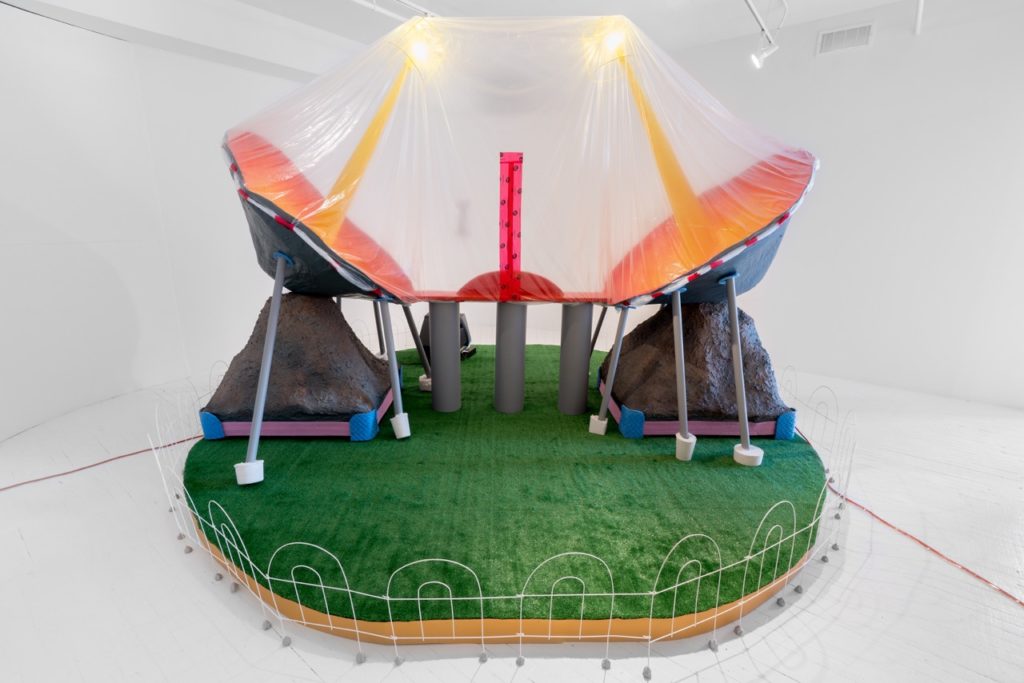 Sherry Walchuk, Sun Tunnel Satellite Dishes (installation view: entrance), 2016–19. Papier mâché, cardboard, wood, tape, plastic, acrylic paint, plaster, lights, astroturf, TV, DVD player, foam and electrical cords, 3.65 x 3.65 x 2.43 m. Photo: Jean-Michael Seminaro.
Sherry Walchuk, Sun Tunnel Satellite Dishes (installation view: entrance), 2016–19. Papier mâché, cardboard, wood, tape, plastic, acrylic paint, plaster, lights, astroturf, TV, DVD player, foam and electrical cords, 3.65 x 3.65 x 2.43 m. Photo: Jean-Michael Seminaro.
